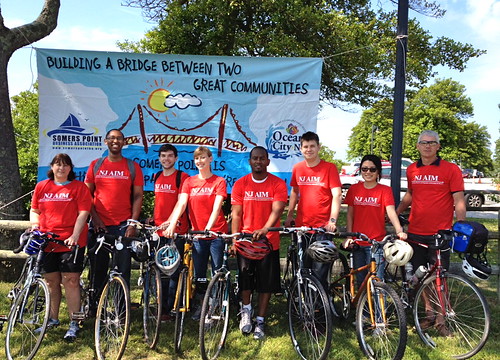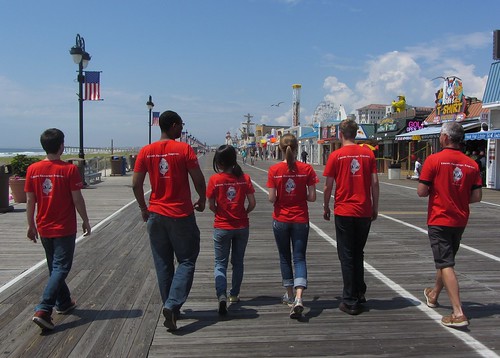Route 52 Causeway Bridge Opening
The New Jersey Department of Transportation, Somers Point, Ocean City and other officials formally opened the new $400 million Route 52 Causeway Bridge connecting Somers Point and Ocean on Thursday, May 24, 2012. The grand opening event was held at the John F. Kennedy Park in Somers Point and consisted of a short speaking program followed by a procession over the new bridge by trolley [and bicycle] to a ribbon cutting on the Ocean City side of the bridge. The event also marked the official debut of the New Jersey Ambassadors in Motion (NJ AIM) pilot program.

Ambassadors with NJDOT Commissioner Simpson at ribbon-cutting
Program Overview
The New Jersey Ambassadors in Motion Program (NJAIM) is a program whose mission is to help make New Jersey roads safer and more attractive for use by all modes—bicyclists, pedestrians, and motorists. The program is managed by Charles Brown, Senior Research Specialist at the Voorhees Transportation Center, and is an initiative of the New Jersey Bicycle and Pedestrian Resource Center (BPRC). The program is funded by the New Jersey Department of Transportation (NJDOT) and the Federal Highway Administration (FHWA).

Ambassadors debut at Grand Opening event
Who are the Ambassadors?
The Bicycle and Pedestrian Ambassadors are the BPRC’s public outreach team. The team consists of adult Ambassadors trained to educate and perform outreach to bicyclists, pedestrians, and motorists to promote safety and active transportation throughout the state of New Jersey. The part-time Ambassadors work from April to November in an effort to fulfill the following goals:
- Promote a culture of courtesy, acceptance, and safety for all modes;
- Strengthen and leverage a network of community organizations and leaders who can advocate on behalf of safe bicycling and pedestrian activity in their communities;
- Provide training and education that helps to transform places and behaviors;
- Encourage non-motorized transportation as a viable alternative to motorized transport; and,
- Encourage everyday safe practices and behaviors by all modes—motorists, bicyclists, and pedestrians.
What do the Ambassadors do?
Ambassadors employ four forms of outreach: event outreach, classroom outreach, on-street outreach, and municipal/governmental outreach and technical assistance. As part of this outreach, Ambassadors work to build relationships with New Jersey counties and local governments and mobilize to attend community events on a select basis. Ambassadors occasionally organize safety and educational events at select locations based upon local demand or unique opportunities. For example, Ambassadors will give bicycle and pedestrian safety presentations targeted to children, youth or adults at after-school locations (e.g., community or cultural centers, senior centers, and street fairs). Ambassadors mobilize at high-pedestrian crash intersections and railroad crossings to distribute safety-related literature to bicyclists and pedestrians and to warn motorists via custom-made signage (e.g., Stop and Stay Stopped). Ambassadors also give presentations on select topics such as Complete Streets Policies to municipal leaders and practitioner communities at meetings, conferences, or other venues.
More specific services provided by NJ AIM include:
- Helmet fittings
- Bicycle safety checks
- Presentations on bicycle and pedestrian safety (English and Spanish)
- Distribution of safety materials and bike maps
- Instruction to motorists and bicyclists on the use of bike lanes
- Demonstrations of NJ Transit bus bike-carrying racks
- Helping non-bikers or novice bikers to bicycle more
- Traffic Skills 101
- Traffic Skills for Commuters
- Traffic Skills for Motorists
- Presentations on Complete Streets policy formation, adoption and implementation
- Presentations on NJ Transit’s Bikes on Trains Policy
Target Groups and Locations
Ambassadors perform outreach statewide. In this pilot year however Ambassadors focus heavily on New Jersey’s 10 largest municipalities with high-pedestrian crash intersections:
- Jersey City
- Edison
- Lakewood
- Woodbridge
- Elizabeth
- Toms River
- Newark
- Hamilton
- Paterson
- Trenton
Within each location, Ambassadors strategically target minority and low-income communities, Limited English Proficiency (LEP) populations, senior centers, vocational schools, community colleges, 4-year college campus towns, railroad crossings, and parks and trails where people bike and walk often. Ambassadors customize education and training programs and messaging to best reach these specific populations and their needs as they relate to walking, bicycling and safety considerations.

Example Target Area for Pedestrian Crashes
Campaigns and Messages
Campaign and messages are critical to the success of the program. In the pilot year, Ambassadors focus on the following campaigns and messages: Active Transportation; Bicycle Safety for Adults; Bike Safety for Kids; Share the Road; Bikes on NJ Transit Buses; Safe Routes to School; Using Your Bike More; Safe Railroad Crossing; and, Complete Streets.
- Active Transportation: This campaign focuses on encouraging the public to consider alternative modes of transportation.
- Bicycle Safety for Adults: This campaign focuses on street riding issues and dangers (riding in the bike lane, avoiding the door zone, communicating to motorists), as well as trail riding (passing other bicyclists). Other topics are helmet wear, respect for all road users, locking safely, and bicycling with family.
- Bike Safety for Kids: This campaign focuses on where to ride (sidewalk vs. street), helmet wear, bike fit, locking your bike, bike handling skills, communicating to pedestrians and motorists, and bikes being fun and liberating.
- Bikes on NJ Transit Buses: This campaign focuses on how to commute by bicycle and bus.
- Safe Routes to School: This campaign focuses educating children and along with their parents how to safely bike and walk to school. This will be a joint effort between BPRC and the SRTS Resource Center.
- Using Your Bike More: This campaign has two main topics:
- Biking to Work or School (what to wear, how to carry, riding at night and in all weather, locking safely, choosing a route, helmet wear).
- Shop By Bike (how to carry, locking safely, choosing a route, helmet wear).
- Safe Railroad Crossing: This campaign focuses educating children and adults how to properly cross railroads.
- Complete Streets: This campaign focuses on encouraging communities to adopt complete streets polices.

Special Events
Throughout the course of the year, NJ AIM will host events in the New Brunswick area to promote safety and active transportation. There will be four events: “First Friday Bike Ride”, “Brown Bag Lunch & Learn”, “Ambassador Roundtable”, and “Car Free Happy Hour”. A more detail description of each event is listed below.
- First Friday Bike Ride: The purpose of this event is to engage and interact with cyclists throughout New Brunswick and the Rutgers community. This event will also serve as a way to educate and demonstrate to students how to safely transverse Rutgers campuses.
- Brown Bag Lunch & Learn: The purpose of this event is to bring in Subject Matter Experts to educate the public on things such as bicycle maintenance, bicycle fit, etc.
- Ambassador Roundtable: The roundtable provides an opportunity for NJ AIM to interact, learn from, and discuss challenges and fears associated with walking and cycling in target communities (e.g., Hispanic and African American).
- Car-Free Happy Hour: The purpose of this alcohol-free event is for the Ambassadors to recruit volunteers into the program. This event will also serve as bonding time for Ambassadors.
Outreach Metrics
Several education and training performance metrics have been developed to monitor the implementation of the pilot program including: 1) number of statewide events attended; 2) number of outreach events at targeted locations and the number of persons reached at each location; 3) number of specific training and educational workshops on various topics held and total persons trained; and 4) the number of people educated on the benefits of bicycling and walking through face-to-face interactions. Surveys will also be distributed to audiences to get feedback on the program’s effectiveness.
Contact Us
If you’d like to volunteer as an Ambassador, or if you’d like the Ambassadors to attend or present an event near you, please contact us at the address, email, or number below.
The New Jersey Bicycle and Pedestrian Resource Center
33 Livingston Avenue, 4th floor
New Brunswick, NJ
P: (848) 932-6814 f: (732) 932-3714
E: nj_bikeped@email.rutgers.edu
